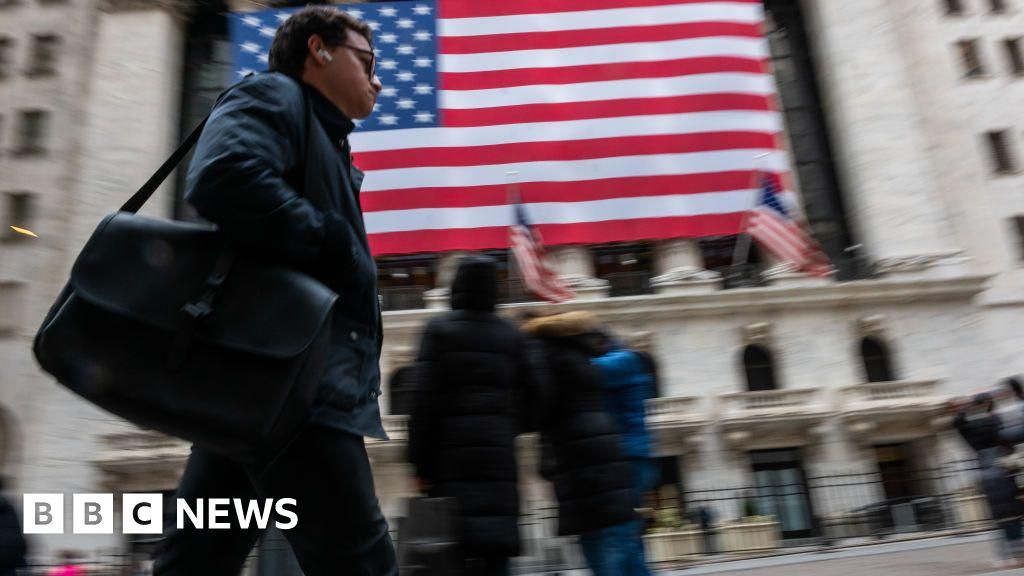Business
FIA nabs Afghan national at Islamabad Airport over fake residence card – SUCH TV

Federal Investigation Agency (FIA) on Thursday thwarted an attempt by an Afghan national to travel to Europe using a forged residence card, intercepting the passenger at Islamabad Airport and taking him into custody.
According to FIA officials, the traveller identified as Janat Gul Niazi was scheduled to fly to France on flight PK-749 when immigration staff detected that he was carrying a fake Greek residence card.
Niazi, who hails from Afghanistan, was immediately offloaded from the flight after the document was found to be counterfeit.
The suspect has since been handed over to the FIA Anti-Human Trafficking Circle, Islamabad, where further investigation and legal proceedings are underway.
Business
US adds more jobs than expected in September

Natalie ShermanBusiness reporter
 Getty Images
Getty ImagesThe first official data in weeks on the US job market is out, and it showed a surprising pick-up in hiring after a lacklustre summer.
Employers added 119,000 jobs in September, more than double what many analysts had expected, but the unemployment rate ticked up from 4.3% to 4.4%, the Labor Department figures showed.
The US government shutdown, which ended last week after more than a month, had delayed publication of the figures for nearly seven weeks, leaving policymakers guessing about the state of the job market at a delicate moment.
Job growth has still barely budged since April, raising pressure on the central bank to cut interest rates to support the economy.
But policymakers at the US central bank, the Federal Reserve, have been divided about the need for further interest rate cuts. In addition to the health of the job market, they are also monitoring price inflation that ticked up to 3% in September, above the 2% rate the bank wants to see.
Looming over the debate are questions like whether artificial intelligence (AI) will dampen demand for workers over the long term and how a crackdown on immigration is changing labour supply and demand.
Businesses are also wrestling with cutbacks to government spending, new tariff costs and uncertain consumer demand.
A private report this month by outplacement firm Challenger, Gray & Christmas found the number of job cuts in October hit the highest number for the month since 2003, as high-profile companies including Amazon, Target and UPS announced reductions.
On Thursday, telecoms giant Verizon also said it was cutting more than 13,000 jobs, citing in part “changes in technology and in the economy” for the move.
The announcements have raised concerns about cracks in what has been seen as a “low-hire, low-fire” job market.
But evidence of wider deterioration has been elusive, as claims for unemployment benefits remain stable.
Health care firms, restaurants and bars led the job gains in September, while transportation and warehousing firms, manufacturers and the government shed jobs.
“The September jobs report may be backward looking but offers reassurance that the labour market wasn’t crumbling before the government shutdown,” said Nancy Vanden Houten, lead economist at Oxford Economics.
However, she noted noting that the data from October is likely to be weaker, due to government layoffs.
Limited hiring has already prompted the ranks of people without work more than six months to swell this year, though their numbers dipped a bit in September.
Unusually, the strains have been particularly pronounced among those with college degrees. The unemployment rate for that group rose to 2.8% in September, up from from 2.3% a year earlier.
“It’s been pretty challenging,” said Mason Leposavic, who has applied to thousands of jobs since graduating in May 2024 from the Rochester Institute of Technology.
 Mason Leposavic
Mason LeposavicWhile the 24-year-old did eventually find part-time work as a bartender, he has failed to find the kind of office role he hoped for in sales, tech or similar sectors.
He said the search had been dispiriting – especially when he saw firms repeatedly re-post openings he had been rejected from for lack of experience – and he was not optimistic it would improve soon.
He is now without work again after switching states to move back in with his mother in Arizona in an attempt to save money.
“I didn’t realise how hard it would be,” he said. “I think everything really changed after AI, especially in the tech industry.”
Information about the situation has been clouded by the government shutdown, which has limited incoming economic data in recent weeks.
Thursday’s report is the last official release on the job market before the Fed’s next meeting in December.
While September’s job gains were stronger than expected, the report also showed job growth in July and August was lower than previously estimated. The US added just 72,000 jobs in July and shed 4,000 positions in August.
The Bureau of Labor Statistics will publish its next report on the November job market in mid-December, leaving a gap in some data for October.
Analysts said the inconclusive nature of the latest figures was likely to bolster the case for the Fed to move cautiously and hold off on cutting in December.
“The Federal Reserve is still driving in a fog,” said Art Hogan, chief market strategist for B Riley Wealth. “As Chair Powell said – ‘When you are driving in a fog, you slow down.'”
Executives from companies such as McDonald’s, Coca-Cola and Chipotle have warned in recent weeks that lower-income households are tightening spending as rising prices put pressure on their budgets and confidence in the job market sinks.
But a strong stock market, bolstered by upbeat reports from many companies, has helped to sustain higher earners.
The Fed has cut its key interest rate twice since September, leaving it in a range of 3.75%-4%, its lowest level in three years.
But Fed chairman Jerome Powell warned last month that another reduction was “far from” a foregone conclusion in December.
At the time he offered reassurance about the job market, saying the mix of data suggested “that you’re seeing maybe continued very gradual cooling, but nothing more than that”.
Business
US stocks today: Wall Street trades in green on hopes of another Fed rate cut; Dow jumps over 660 points, Nasdaq near 2.5% gains – The Times of India

US markets traded in green on Thursday as investors welcomed fresh signs that pressure on Wall Street may be easing, with Nvidia’s latest earnings and renewed hopes of another interest rate cut by the Federal Reserve. Dow jumped 662 points or 1.44% to 46,801. Nasdaq also rose to 23,134 up, 569 points or 2.5% at 8:30 PM IST. S&P500 also followed the suit, rising 126 points or 1.9%.The gains also came after Nvidia delivered another heavyweight profit update, calming concerns that enthusiasm around artificial intelligence might be fading. Walmart’s stronger-than-expected results also helped lift sentiment. Ahead of the opening bell, futures trading pointed clearly to a risk-on mood. S&P 500 futures gained 1.6%, while futures tied to the Dow advanced 1% and the Nasdaq added 2.1%. Nvidia shares rose 5.2% in pre-market activity after the chipmaker posted a summer profit that outpaced Wall Street expectations and released a revenue forecast that once again sailed past analysts’ estimates. The company’s ability to repeatedly exceed projections has strengthened its role at the heart of market volatility. Nvidia, now the most valuable firm on Wall Street and briefly worth more than $5 trillion, holds such a large weight in the S&P 500 that its daily swings can set the tone for the entire index. Recent doubts about whether AI-linked stocks had surged too far, too fast have rattled markets, but the latest earnings figures offered investors a renewed sense of assurance. Nvidia’s dominance has also made it a proxy for the wider AI build-out, with companies across industries relying on its chips to expand their artificial-intelligence capabilities. Markets also reacted to new figures on the U.S. labour market. Government data showed hiring in September was stronger than economists had projected, although the unemployment rate rose slightly. The mixed report kept hopes alive that the Federal Reserve could cut interest rates again at its December meeting. The central bank has already trimmed rates twice this year as the job market has gradually slowed. However, some Fed officials have recently suggested that holding off next month may be prudent, warning that inflation’s persistence above the 2% target leaves little room for complacency. Lower rates can stimulate the economy and lift asset prices, but they also risk fuelling further inflation. Overseas markets largely mirrored the positive tone. Germany’s DAX rose 1.3%, London’s FTSE 100 advanced 0.7%, and France’s CAC 40 posted a 1.1% gain. In Asia, Japan’s Nikkei 225 posted a 2.6% rise as tech stocks rallied, while South Korea’s Kospi increased by 1.9%. Chinese indices closed mixed amid reports that Beijing may be preparing new steps to support its struggling property sector. With Nvidia once again surpassing expectations and broader economic data offering room for optimism, Thursday’s session marked a rare stretch of calm after weeks of uncertainty across global markets.
Business
Save 13% On Your Wedding Hall Bookings With This Little-Known GST Trick

Last Updated:
Couples on a tight budget can save more by cutting food costs, opt for popular dishes and a smaller menu to significantly reduce wedding expenses

When booking separately, a GST of 18% is applied to the hall, and 5% to catering. (AI Generated/News18 Hindi)
As wedding season approaches, many couples are faced with the daunting task of managing wedding expenses, which begin to pile up once the invitations are printed. Major costs include attire, jewellery, decorations, entertainment, photography, catering, gifts, and the venue, with the latter often being the most significant expense.
Booking a banquet hall or resort for a single evening can range between Rs 1 lakh to Rs 2 lakh. During peak seasons, venue owners often hike their prices, making it seem like renting a palace.
However, there are ways to save on these costs. Instagram finance influencer Binge Wealth reveals that one can save up to 13% on hall bookings by opting for a combined service from the same vendor. When booking the hall and catering separately, a GST of 18% is applied to the hall, and 5% to catering. Yet, booking both services together counts as a ‘composite supply’, incurring only a 5% GST on the entire package.
To illustrate, consider a banquet hall with a base rent of Rs 5 lakh. Separate bookings would entail a GST of Rs 90,000 for the hall (18% of Rs 5,00,000) and Rs 10,000 for catering (5% of Rs 2,00,000), totalling Rs 1,00,000.
By booking both from one vendor, the composite supply GST on the combined amount of Rs 7 lakh (Rs 5 lakh for the hall and Rs 2 lakh for catering) would be Rs 35,000, resulting in direct savings of Rs 65,000. This translates to savings of around 13% (Rs 55,000) on a Rs 5 lakh hall and over Rs 1 lakh on a Rs 10 lakh hall.
Siddharth Maurya, founder and managing director of Vibhavangal Anukoolkara Private Limited, emphasises that the biggest savings in a wedding budget often come from tax structure optimisation.
Couples frequently overlook this aspect, but booking the hall and catering together can slash costs by 10-13%. For a typical wedding, this simple strategy can save thousands, if not lakhs, without additional effort.
For those desiring a grand celebration on a tight budget, further savings can be made by reducing the cost of food plates and selecting only the most popular dishes. Limiting the menu to fewer items can significantly cut costs, as a broader selection usually means higher expenses. Additionally, modest adjustments to hall decorations can prevent overspending on decor.
November 20, 2025, 18:57 IST
Read More
-

 Tech5 days ago
Tech5 days agoNew carbon capture method uses water and pressure to remove CO₂ from emissions at half current costs
-

 Politics7 days ago
Politics7 days agoBritish-Pakistani honoured for transforming UK halal meat industry
-

 Sports5 days ago
Sports5 days agoTexas A&M officer scolds South Carolina wide receiver after touchdown; department speaks out
-

 Business5 days ago
Business5 days agoThese 9 Common Money Mistakes Are Eating Your Income
-

 Sports6 days ago
Sports6 days agoApple scrapping MLS Season Pass service in ’26
-

 Business6 days ago
Business6 days agoWhat’s behind Rachel Reeves’s hokey cokey on income tax rises?
-

 Fashion6 days ago
Fashion6 days agoAfter London, Leeds and Newcastle, next stop Glasgow for busy Omnes
-

 Tech6 days ago
Tech6 days ago$25 Off Exclusive Blue Apron Coupon for November 2025













